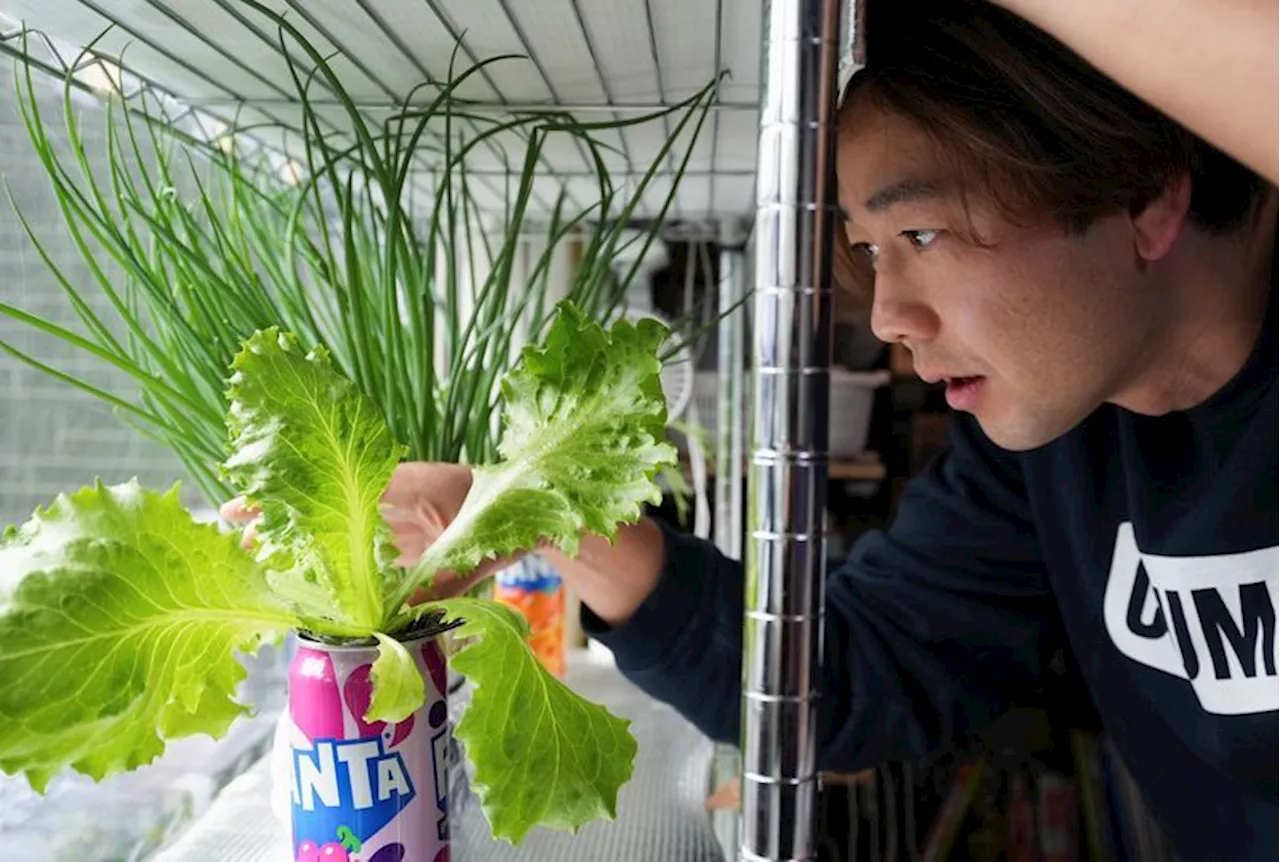Rising food prices in Japan are leading many to explore new ways to stretch their grocery budgets. From reusing leek roots to embracing indoor farming, Japanese consumers are finding innovative solutions to cope with the surge in the cost of everyday staples, particularly cabbage, a key ingredient in the popular dish 'okonomiyaki'.
Japan ese homemaker Kirina Mochizuki has always considered 'okonomiyaki' savory pancakes the ultimate comfort food: simple, satisfying, and cheap. These days, though, it's a struggle to get the dish, a favorite among Hiroshima natives like herself, on the table. With the price of cabbage - a key ingredient - tripling recently, Mochizuki makes daily trips to the supermarket in search of discounted produce, or resorts to using dried seaweed.
'I never imagined that okonomiyaki would become a delicacy,' the mother-of-two said, adding she had also taken to re-growing leek in a glass of water using the usually discarded root base. With inflation taking hold in Japan after a generation of stagnant prices, many consumers are facing a similar plight, and looking for creative solutions to ease the pain. Data on Friday showed the average price of cabbage more than tripling this month in the capital, Tokyo, from a year ago. The Bank of Japan hiked interest rates to the highest in 17 years last week citing confidence in the outlook for salaries. But inflation-adjusted wages have fallen in 29 of the last 32 months while the Engel's coefficient, or the share of households' spending on food, hit a four-decade high last year. The price of a head of cabbage reaching 1,000 yen ($6.43) in Tokyo - roughly equivalent to an hourly wage - had already made headlines even before Friday's data, and the central bank noted last week that rice would probably stay expensive until the spring of 2026. Wholesale rice prices surged 60% in December from the same period a year earlier. As the price of agricultural products has risen, Japanese have also been eating less of them. The average intake of vegetables among Japanese adults fell to an all-time low in November, the most recent government data shows. Meanwhile, cheap 'furikake', or dried condiments sprinkled on rice, are being used as a substitute for other dishes on the dinner table. Sales last year are expected to have reached a record high, according to research firm Fuji Keizai. 'A 10-yen rise in our daily goods might seem small but it adds up,' Mochizuki said, noting that she had already shaved what she could from other spending. Worried about the impact of rising prices on voter sentiment, the government last year compiled an economic stimulus package that includes cash payouts to low-income households. And in a first, the farm ministry is considering drawing up new rules to allow the government to sell stockpiled rice to agricultural cooperatives with the aim of bringing down retail prices.Having started indoor farming at home as a hobby during the pandemic, the 37-year-old now has nearly 90,000 subscribers eager to learn how to stretch out store-bought vegetables and grow new ones in containers of water, without soil. 'I've seen 4,500 new followers in the past two weeks,' he told Reuters at his home in Kawasaki, outside Tokyo, this week. Nakata quit his job at an electronics retailer in 2023 to focus on the 47 types of vegetables he currently grows all over his house. Everything from shiso leaves, onions, and daikon radish thrive in empty plastic bottles, beer cans, and even the basket of his bicycle.Nakata's family has had to sleep without air conditioning on sweltering summer nights, and his wife complains that she can't breast-feed her newborn in the living room because the curtains need to be open to ensure the leafy greens get their sunlight. Still, with vegetable prices so high, Nakata says the sacrifices have paid off. He recently succeeded in cultivating a robust patch of cabbage leaves in a kitchen bowl using the inedible core and liquid fertilisers - the subject of his next video on YouTube. 'Home gardening has really helped us slash our spending on food, so I want to share my findings,' he said
Food INFLATION JAPAN FOOD PRICES CABBAGE OKONOMIYAKI INDOOR FARMING CONSUMERISM
Malaysia Latest News, Malaysia Headlines
Similar News:You can also read news stories similar to this one that we have collected from other news sources.
 ‘It’s obscene’: Desperate survivors of LA fires face soaring rents, price gougingSANTA MONICA, Jan 12 — Five days after an inferno razed Pacific Palisades, Maya Lieberman is desperate to find somewhere to live. But unscrupulous landlords who are jacking up...
‘It’s obscene’: Desperate survivors of LA fires face soaring rents, price gougingSANTA MONICA, Jan 12 — Five days after an inferno razed Pacific Palisades, Maya Lieberman is desperate to find somewhere to live. But unscrupulous landlords who are jacking up...
Read more »
 Call of Duty's Soaring Budgets: $700 Million for Black Ops Cold WarNew court filings reveal the staggering development costs of Call of Duty: Black Ops Cold War, reaching $700 million despite lower sales compared to previous entries. This information, part of a lawsuit against Activision related to the Uvalde school shooting, showcases a concerning trend of increasing production budgets for Call of Duty games.
Call of Duty's Soaring Budgets: $700 Million for Black Ops Cold WarNew court filings reveal the staggering development costs of Call of Duty: Black Ops Cold War, reaching $700 million despite lower sales compared to previous entries. This information, part of a lawsuit against Activision related to the Uvalde school shooting, showcases a concerning trend of increasing production budgets for Call of Duty games.
Read more »
 Japanese 'God of Freebies' Finds Joy in Frugal LifestyleA 75-year-old Japanese man, Hiroto Kiritani, has become an internet sensation for his extreme frugality. Despite amassing a fortune in the stock market, Kiritani takes advantage of every coupon and free offer available, living a surprisingly simple lifestyle.
Japanese 'God of Freebies' Finds Joy in Frugal LifestyleA 75-year-old Japanese man, Hiroto Kiritani, has become an internet sensation for his extreme frugality. Despite amassing a fortune in the stock market, Kiritani takes advantage of every coupon and free offer available, living a surprisingly simple lifestyle.
Read more »
 Japanese Tourist Fined for Defying Police in Chiang MaiA Japanese tourist was fined for grabbing a policeman's collar in Chiang Mai after being stopped from releasing a floating lantern in a restricted area.
Japanese Tourist Fined for Defying Police in Chiang MaiA Japanese tourist was fined for grabbing a policeman's collar in Chiang Mai after being stopped from releasing a floating lantern in a restricted area.
Read more »
 Japanese Company Uses AI to Train Customer Service StaffA Japanese company is employing AI technology to train new customer service employees, aiming to improve their resilience and adaptability in dealing with demanding customers.
Japanese Company Uses AI to Train Customer Service StaffA Japanese company is employing AI technology to train new customer service employees, aiming to improve their resilience and adaptability in dealing with demanding customers.
Read more »
 World's oldest woman, Japanese Tomiko Itooka, dies at 116The world's oldest person, Japanese woman Tomiko Itooka, has died at the age of 116.
World's oldest woman, Japanese Tomiko Itooka, dies at 116The world's oldest person, Japanese woman Tomiko Itooka, has died at the age of 116.
Read more »
